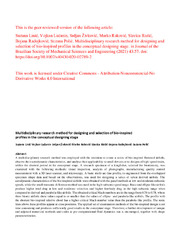| dc.creator | Linić, Suzana | |
| dc.creator | Lučanin, Vojkan | |
| dc.creator | Živković, Srđan | |
| dc.creator | Raković, Marko | |
| dc.creator | Ristić, Slavica | |
| dc.creator | Radojković, Bojana | |
| dc.creator | Polić, Suzana | |
| dc.date.accessioned | 2023-12-25T11:28:53Z | |
| dc.date.available | 2023-12-25T11:28:53Z | |
| dc.date.issued | 2021 | |
| dc.identifier.issn | 1678-5878 | |
| dc.identifier.uri | http://rimsi.imsi.bg.ac.rs/handle/123456789/3112 | |
| dc.description.abstract | A multidisciplinary research method was employed with the intention to create a series of bio-inspired flattened airfoils,
observe their aerodynamic characteristics, and analyse their applicability to small devices or to designs of high-speed trains,
within the shortest period in the conceptual stage. A research specimen of a kingfisher, selected for biomimicry, was examined
with the following methods: visual inspection, analysis of photographs, manufacturing quality control measurement with a
3D laser scanner, and microscopy. A basic multi-arc-line profile, re-engineered from the overlapped specimen shape data and
based on the observations, was used for designing a series of seven derived airfoils. The aerodynamic characteristics of the
bio-inspired airfoils were obtained with the panel methods at low and moderate subsonic speeds, while the small transonic
difference method was used in the high-subsonic speed range. Basic and ellipse-like airfoils produce higher total drag at low
and moderate velocities and higher forebody drag in the high-subsonic range when compared to derived and parabola-like
airfoils. The obtained critical Mach numbers are in the range from 0.76 to 0.78, where three bionic airfoils show values equal
to or smaller than the values of ellipse- and parabola-like airfoils. The profile with the shortest bio-inspired relative chord
has a higher critical Mach number value than the parabola-like profile. The sonic lines above these profiles appear at close
positions. The applied set of examination methods of the bio-inspired design is not time consuming and produces sufficiently
good results in the conceptual stage. Therefore, a further development of unique and adjusted numerical methods and codes
at pre-computational fluid dynamics run is encouraged, together with shape parameterization. | sr |
| dc.language.iso | en | sr |
| dc.publisher | Springer | sr |
| dc.relation | info:eu-repo/grantAgreement/MESTD/Technological Development (TD or TR)/35045/RS// | sr |
| dc.relation | info:eu-repo/grantAgreement/MESTD/Technological Development (TD or TR)/34028/RS// | sr |
| dc.rights | openAccess | sr |
| dc.rights.uri | https://creativecommons.org/licenses/by-nc-nd/4.0/ | |
| dc.source | Journal of the Brazilian Society of Mechanical Sciences and Engineering | sr |
| dc.subject | Aerodynamics | sr |
| dc.subject | Design | sr |
| dc.subject | Bionics | sr |
| dc.subject | Quality measurement | sr |
| dc.subject | Laser scanning | sr |
| dc.subject | Numerical method | sr |
| dc.title | Multidisciplinary research method for designing and selection of bio‑inspired profiles in the conceptual designing stage | sr |
| dc.type | article | sr |
| dc.rights.license | BY-NC-ND | sr |
| dc.citation.spage | 57 | |
| dc.citation.volume | 43 | |
| dc.identifier.doi | https://doi.org/10.1007/s40430-020-02789-2 | |
| dc.identifier.fulltext | http://rimsi.imsi.bg.ac.rs/bitstream/id/8147/brasilian_journal1.pdf | |
| dc.type.version | acceptedVersion | sr |

